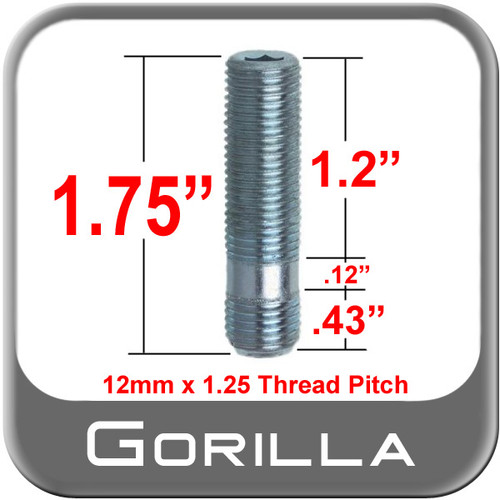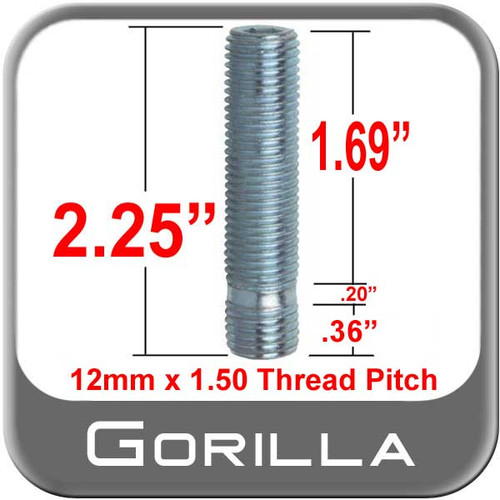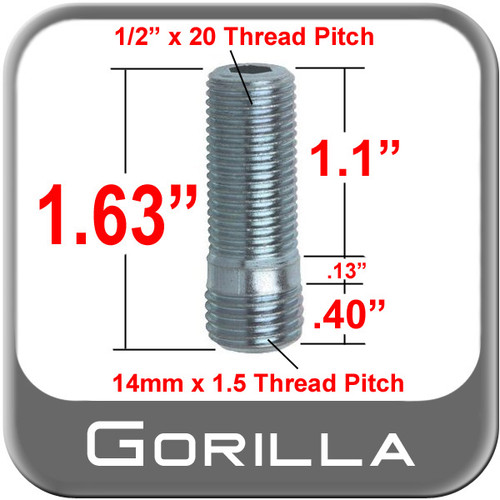-

Gorilla
Gorilla® Silver Wheel Stud Open (Female) Sold Individually #77728
(Reg. $1.93$1.6912mm x 1.25 Thread
Gorilla Brand -

Gorilla
Gorilla® Silver Wheel Stud Open (Female) Sold Individually #77788
(Reg. $2.88$2.531/2" x 20 Thread
Gorilla Brand -

Gorilla
Gorilla® Silver Wheel Stud Open (Female) Sold Individually #77738L
(Reg. $2.52$2.2112mm x 1.50 Thread
Gorilla Brand -

Gorilla
Gorilla® Silver Wheel Stud Open (Female) Sold Individually #77738S
(Reg. $2.52$2.2112mm x 1.50 Thread
Gorilla Brand -

Gorilla
Gorilla® Silver Wheel Stud Open (Female) Sold Individually #77738XL
(Reg. $2.70$2.3712mm x 1.50 Thread
Gorilla Brand -

Gorilla
Gorilla® Silver Wheel Stud Open (Female) Sold Individually #77748N
(Reg. $3.91$3.4314mm x 1.50 + 1/2" x 20 Thread
Gorilla Brand -

West Coast Wheel
West Coast Wheel® Silver Wheel Stud Open (Female) Sold Individually #198-STUD6-38
(Reg. $2.27$1.9912mm x 1.25 Thread
West Coast Wheel -

West Coast Wheel
West Coast Wheel® Silver Wheel Stud Open (Female) Sold Individually #198-STUD7-38-XL
(Reg. $2.27$1.9912mm x 1.50 Thread
West Coast Wheel -

West Coast Wheel
West Coast Wheel® Silver Wheel Stud Open (Female) Sold Individually #198-STUD7-75-L
(Reg. $2.27$1.9912mm 1.75 + 12mm 1.50 Thread
West Coast Wheel -

West Coast Wheel
West Coast Wheel® Silver Wheel Stud Open (Female) Sold Individually #198-STUD9-38
(Reg. $2.27$1.9914mm x 1.50 Thread
West Coast Wheel -

West Coast Wheel
West Coast Wheel® Silver Wheel Stud Open (Female) Sold Individually #198-STUD94-38
(Reg. $2.27$1.9914mm x 1.50 + 1/2" x 20 Thread
West Coast Wheel -

West Coast Wheel
West Coast Wheel® Silver Wheel Stud Open (Female) Sold Individually #198-STUD94-38L
(Reg. $2.27$1.9914mm x 1.50 + 1/2" x 20 Thread
West Coast Wheel
Wheel Studs
Wheel Studs
Wheel lug studs are the screw or bolt-like pieces that your car's lug nuts are threaded on to in order to secure the wheels to the car. Every now and then, for a variety of reasons, these wheel lug studs will require a wheel stud replacement procedure. The original wheel studs on your car can rust and become unusable, or the rust can cause the wheel lug studs to break when trying to remove the wheel for servicing.
